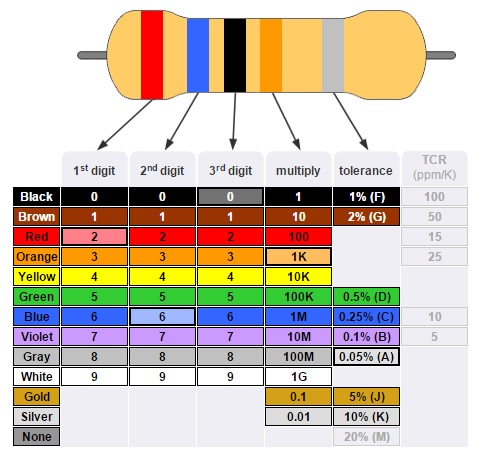

The beige-colored body of a resistor is often an indication that its tolerance is 5%, while a blue-colored body often indicates a tolerance of 1% or 2%. Alternatively, most of the colors are those from the traditional rainbow. Below are some given roles which help to know the exact value of an SMD resistor by seeing the printed character codes on those tiny chips.īlack, Brown, Red, Orange, Yellow, Green, Blue, Violet, Grey, White 0, 1, 2, 3, 4, 5, 6, 7, 8, 9. These tiny chips are marked with three (3) or four (4) digit codes which are called SMD Resistor codes to indicate their resistance values. The fourth color band signifies tolerance.

This multiplier will basically shift your decimal place around to change your value from megaohms to milliohms and anywhere in between. On a three or four-band resistor, the third band represents the multiplier. What does the third band on a resistor represent? Therefore, the first three bands indicate the significant digits, the fourth band is the multiplying factor and the fifth band represents the tolerance.ġ0. Resistors with high precision have an extra band to indicate a third significant digit. What does the fifth band on a resistor mean? Which digit is represented by a blue band on a resistor?ĩ. For a 4 band resistor color code, we can begin by first finding the tolerance band as it is usually gold or silver.Ĩ. The third band represents the multiplier while the fourth band represents tolerance. Similar to the 3 band resistor, the first two bands always give the first 2 digits of the resistance value. What does the third color band is silver mean? The values of color bands will be like this: Green = 5, Brown = 1, Violet = 7, Black = 100, Gold = 5%, Orange = 15ppm.ħ. If the colors on a 6 band resistor is in this order: green, brown, violet, black, gold and orange. How do you read a 6 band resistor color code?

This indicates how much the actual resistance value of the resistor changes when the temperature changes.Ĭolour Code: Yellow, Violet, Orange, GoldĦ. The 6th band for a 6-band type resistor is the temperature coefficient. Here, two colors are added (gold and silver). The fourth band (or 5th for the 5-band and 6-band) indicates the tolerance values. The fourth and fifth bands are used to determine the percentage tolerance of the resistor. How do you calculate the resistor color code?įor example, a resistor has the following coloured markings Yellow Violet Red = 4 7 2 = 4 7 x 102 = 4700Ω or 4k7 Ohm. Next comes a small gap - helping you to distinguish the left and right of the component - and finally the fourth band indicating tolerance of the resistor.Ģ. With 4 bands the first and second band represent the first and second significant digit of the ohm value, the 3 band is the decimal multiplier. How do you determine the color code of a 4 band resistor?


 0 kommentar(er)
0 kommentar(er)
